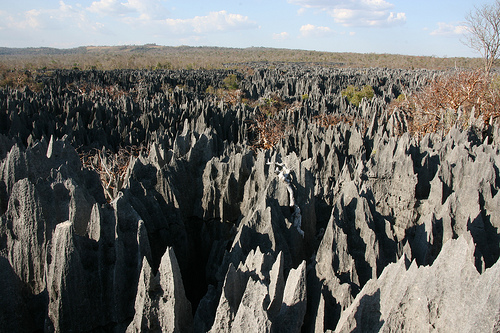Tsingy de Bemaraha World Heritage Site is a site of wonder and awe.
- The Tsingy de Bemaraha World Heritage Site is a rock plateau and forest located in western Madagascar, a large island, off the coast of Africa.
- The Tsingy de Bemaraha World Heritage Site covers an area of around 1520 square kilometres (587 square miles), with approximately half of which is rock formations and the other forest.
- The Tsingy de Bemaraha World Heritage Site became a UNESCO World Heritage Site in 1990.
- The Tsingy de Bemaraha World Heritage Site is broken up into a national park in the south, containing mostly rock formations, and a strict nature reserve in the north, featuring forests, lakes and other landforms.
- The Tsingy de Bemaraha World Heritage Site is famously home to an abundance of pointy limestone rock formations, known as ‘tsingys’, that have been formed by the erosion of water, and tower up to 100 metres (328 feet).
Part of Tsingy de Bemaraha World Heritage Site
Image courtesy of Marco Zanferrari/Flickr
- Parts of the Tsingy de Bemaraha World Heritage Site are also known as ‘Tsingy’, ‘Tinsgy de Bemaraha’, ‘Tsingy de Bemaraha Nature Reserve’, ‘Tsingy de Bemaraha Strict Nature Reserve’, and ‘Tsingy de Bemaraha National Park’.
- The Tsingy de Bemaraha World Heritage Site is home to many unique or endangered animals, including lemurs, chameleons, iguanas and frogs, as well as 140 different bird species and 650 plant species.
- The Tsingy de Bemaraha World Heritage Site, first welcomed visitors in 1998, when part of the site was designated as a national park, and the area takes 2 to 3 days to explore and is only accessible from April to November due to wet weather conditions during the rest of the year.
- The ‘Tsingy de Bemaraha World Heritage Site’ gets its name from the word ‘tsingy’, which comes from Madagascar’s Malagasy language, meaning ‘where one cannot walk barefoot’ or ‘to walk on tiptoes’.
- Tsingy de Bemaraha World Heritage Site is quite isolated and difficult to explore, and it can take a few days to reach by car on rough roads, or it can be accessed by the Manambolo river or by aircraft.






thanks for the info